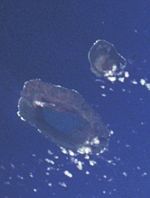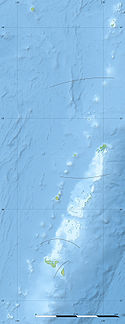| Kao (volcano) | |
|---|---|
 Kao (smaller island) and Tofua (bigger island) | |
| Highest point | |
| Elevation | 1,030 m (3,380 ft) |
| Prominence | 1,030 m (3,380 ft) |
| Listing | Country high point |
| Coordinates | 19°40′12″S 175°01′48″W / 19.67000°S 175.03000°W |
| Geography | |
| Geology | |
| Mountain type | Stratovolcano |
| Last eruption | 1847[1] |
Kao is an island and stratovolcano in Tonga. It reaches 1,030 m (3,379 ft) above sea level, the highest point in Tonga. Although the island does not display fresh-looking lava flows, it is likely very recent in origin due to the absence of deep gullies or high sea cliffs. Kao lies about 6 km (3.7 mi) north of Tofua island. The slopes of the island rise at angles exceeding 35 degrees to the summit, which has a series of small volcanic craters. An eruption from Kao was reported on July 10, 1847.[1]
The best access to Kao is by small boat on the South Coast of the island, although heavy swell can make this treacherous and a skilled boat coxswain is required. There are no permanent paths up to Kao's summit. Small areas on the lower slopes are cultivated by kava growers. The island is densely jungled on its lower flanks, interspersed with thick chest height ferns that are virtually impassable to all but the most determined trekkers armed with machetes and a good deal of stamina. Although just passable, the jungle area itself ends with a tree line at approximately 400m up the mountain, a brief belt of more thick fern gives way to shorter fern growth. However, 75m from the summit the thick fern returns. Kao is an exceptionally difficult hike and climb. There are many gullies and ravines, some covered in plant growth, difficult to see and treacherous.
The oral tradition of Kao and Tofua
E. W. Gifford, recording Tongan myths and tales in the 1920s, documented this explanation for Tofua's caldera and the creation of Kao Island to the north:
"Three deities from Samoa, Tuvuvata, Sisi, and Faingaa, conspired to steal Tofua. So they came and tore up the high mountain by its very roots and its place was taken by a large lake. This enraged the Tongan gods very much and one of them, Tafakula, essayed to stop the thieves. He stood on the island of Luahako and bent over so as to show his anus. It shone so brilliantly that the Samoan deities were struck with fear, thinking that the sun was rising and that their dastardly work was about to be revealed. Hence, they dropped the mountain and fled to Samoa. The mountain became the island of Kao."[2]
See also
References
- ^ a b "Kao". Global Volcanism Program. Smithsonian Institution. Retrieved 2020-05-05.
- ^ E. W. Gifford, Tongan myths and tales, Honolulu: Bernice P. Bishop Museum Bulletin, No. 8
External links
- Invasive plant species threatening Kao endemic flora
- "Kao, Tonga". Peakbagger.com.
